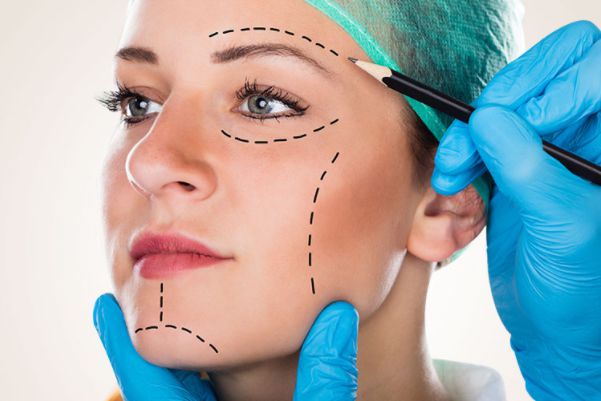
In the world of facelifts, there are two primary options to consider. Surgical vs non-surgical facelifts is one of the most debated topics in the world of beauty treatment. If you’re trying to rejuvenate your look, it’s likely that you have heard one or two different things about both types of facelifts.
In trying to maintain your youthful look, you may have considered getting a facelift. But you are scared because your friend who had the procedure had a terrible job done. You may also be terrified of going under the knife. Surgical facelifts aren’t the only rejuvenating treatment available to you.
There are several cosmetic options available to you to help you improve your appearance. In this blog, we’ll be comparing surgical treatments with a non-surgical facelift.
This article unravels these two options to discover which is best between surgical and non-surgical facelifts. We understand that making a decision on the best one can be complicated. To that end, we will provide you with all the necessary information to help you make that decision. Let’s dive in!
Do You Need A Facelift?
Age does a number on your body, particularly your skin. As the years start to add up, your body starts to decline in many functions. One of those functions of the skin is the production of structural proteins: collagen and elastin.
The importance of these compounds to your skin integrity is enormous. Collagen helps to keep your skin firm and taut while the other ensures your skin remains elastic. These two activities result in smooth and healthy-looking skin.
Their absence results in many unpleasant skin forms. Wrinkles, fine lines, and creases are not uncommon occurrences. You may also experience your skin sagging, leaving you with jowls and a very elderly look.
If you are starting to see this and are unhappy and less confident about how you look, you may well begin debating surgical vs. non-surgical facelift options.

Going The Surgical Way: Here’s What To Expect
In time past, going the surgical way has been the most common method of dealing with skin issues. It was also the most effective means. A surgical facelift is also called a rhytidectomy. In the simplest terms, the surgical facelift lifts and tightens your face.
The more expanded version is that soft tissues at particular parts of your face (the mid and lower face most commonly) get repositioned. You may also request that your neck be included in the facelift efforts.
Excess bits of skin are trimmed, and any creases or folds are smoothed. Eye or brow lifts are not ordinarily part of facelifts but are often done at the same time.
How it is done
Traditional (surgical) facelifts are just like other medical surgeries. They often require you to be put out, and general anesthesia is often employed. This is a big difference between surgical and non-surgical facelifts. Because they are so delicate, they must be performed by a professional in the best medical environment possible.
Once all the preliminary steps have been taken, your surgeon makes an incision in your face at the temple. The incision extends down the front of your ears and around it. It then goes behind the ears at the lower scalp.
Next is to redistribute or remove the fat under the skin, as is necessary for the results you hope to achieve. Excess skin is trimmed and tightened. Your facial muscles and tissues are also adjusted to your requirements.
If a neck lift is involved, the incision is done under the chin, and excess skin and fat are removed. The skin is pulled to tighten it. You may not require extensive incisions if the saggy skin is only little.
Once the changes have been made, your skin is sutured and glued back into place. You need not worry about marks from the incisions being conspicuous post-op. The incisions are usually done to merge with your hairline naturally – it goes unnoticeable.
What Are The Non-surgical Options for a Face Lift
Essentially, the hallmark of the non-surgical facelift is that it is, at worst, only minimally invasive. Non-surgical facelift encompasses a combination of treatments and procedures that rejuvenate the face and make you look younger.
For the most part, you do not get incisions or need general anesthesia for these procedures. You also will not require hospitalizations with these methods.
Non-surgical facelifts can usually help with volume loss on the face and damage from sun exposure. Mostly, non-surgical facelift results address deep creases, fine lines, thin lips, large pores, sunken cheeks, and acne scars.
Below are some of the treatments that make up a non-surgical facelift:
Dermal Fillers
This treatment is one of the most important non-surgical facelift options. Dermal fillers are gel-like substances injected into the folds, creases, and wrinkles of the skin. The fillers used are often made from naturally occurring substances.
One of the most common fillers used is hyaluronic acid. It is easily found in the body, and so it is safe to use. It plumps up the parts of the body it is injected into. It also helps to pull moisture and hydrate your skin.
Hyaluronic acid and other types of dermal fillers also help to stimulate collagen production. Dermal fillers mainly help with increasing facial volume and reducing wrinkles. The overall effect is that you re-discover your youthful look. Dermal fillers are the liquid facelift.

Botox
Botox is a big deal in cosmetic procedures. You must have heard of the use of Botox injections to give the face a real change. Botox, which contains botulinum toxin from bacteria, causes the muscles in your face to relax.
This happens because the toxin blocks nerve signals and prevents your muscles from contracting. This removes any frown or smile lines and gives you a wrinkle-free appearance. Botox also reduces the rate at which new creases and folds form.
Like the fillers, botox is temporary, and after about three to four months, a retouch may be necessary.
Microneedling
This method involves using tiny needles to make holes in the skin. The needles help apply heat to the deeper layers of your skin, after which the serum is applied.
As the skin heals, collagen production is stimulated. This helps to firm up your skin and helps to improve sagging and scarring. In the end, you’ll be left with a smooth face and improved texture.
Ultherapy
Ultherapy also works to tighten the skin after it loses its elasticity. This method involves applying heat energy to lower layers of the skin. What happens is that the facial muscles in that area tighten.
It is an expensive treatment – at least more so than the other non-surgical facelift methods. The results from this procedure can last up to a year.
Chemical peels
Chemical peels are applied to your face to remove dead skin cells. Doing this allows new skin cells to grow and thrive.
Laser resurfacing
Laser resurfacing serves to remove the old layers of the skin using laser energy. It works for skin issues caused by sun damage, acne, uneven skin tone, and the classic ageing effects.
After you undergo ablative laser resurfacing, a new, fresh skin layer emerges. You may have to undergo repeat treatment – this is a significant difference between surgical and non-surgical facelifts. However, the results often last for years.
Microdermabrasion
This treatment is a new, increasingly popular method of exfoliation. It majorly works to exfoliate your skin, produce a unique, smoother texture, and renew your skin tone.
Dead cells are removed, and blood circulation in your skin is much improved. Hyperpigmentation, sun damage, enlarged pores, and stretch marks can all be taken care of by microdermabrasion.
You may have noticed that some of these methods have a particular function. It is not uncommon for these techniques to be used in combination to provide the overall facelift effect. If you are starting to warm up to the idea of non-surgical facelift procedures, you should visit a board-certified professional aesthetician to discuss your options.
Related article: Busting Top Myths about Facelifts
Surgical vs. Non-surgical facelifts: The Pros and Cons
In helping you make a better decision, we will examine the benefits of non-surgical and surgical facelifts. We will also consider where each method does not measure up. This will help you make the best decision.
Convenience
A surgical facelift is not the most convenient method to restore and restore your face. There are indeed innovative means for your surgeon to make the procedure easy and safe and achieve better results.
However, you have to undergo surgery, where cuts are going to be made. You will also have to be put under for the procedure. When you compare it to the minimally invasive non-surgical methods, you realize the stark difference in convenience.
The non-surgical options require little preplanning, and you can easily pop in to the center and get your treatment. Another benefit of the non-surgical facelift is that it takes very little time.
You can quickly be finished with most treatments in an hour at most. But surgery takes considerable time to get done.
Aftercare and recovery time
After the surgery, you will have bandages wrapped around your face and a surgical drainage tube to manage. You may also have sutures that require you to return to the doctor for removal.
Additionally, you may have to spend considerable time before you can get back to your original level of functioning. All these results in a lot of efforts in aftercare and a lengthy recovery time.
With the non-surgical facelift, you have little to do in aftercare. Bruising and swelling are expected for most procedures. But you can easily manage them with a cold compress and pain medication.
Furthermore, the treatments take next to nothing from you. So, you should be ready to resume your daily activities soon after the procedure is done.
Permanence
You cannot undo the results of the surgery. This means you have to be sure that project results are what you wanted. In the same vein, surgical facelifts can last for an extended period. You will not need a repeat of the job.
However, non-surgical facelifts are distinguished by their need for frequent touch-ups. The materials used for many of these procedures are natural and eventually get absorbed into the body. This is why the effects do not last for very long.
You may also choose a non-surgical facelift because its effects are reversible. Hyaluronidase is an enzyme used to remove the filler if you are not satisfied with the results. Botox treatments are temporary, with treatment results lasting for about four months on average.
This provides a solution if you do not eventually like your treatment. Your doctor can melt it away. You may also wait as the effects will wear off with time.

Costs
On a per treatment basis, a surgical facelift will set you back quite a lot. Surgeries are generally expensive. You will have to factor in extra costs like that of pain medications, which are usually required.
You may get to save more if you choose to go with non-surgical treatment options. But because you will likely have repeat treatments, your non-surgical facelifts can amount to more than the surgical option in the long run.
However, non-surgical facelift results are cumulative. Over time, you will have less need for subsequent treatments. This may help to reduce the overall cost of the treatment.
When you compare surgical and non-surgical facelifts’ costs, you may find it easier to pay small amounts periodically. This reduces financial pressure from your cosmetic procedures.
Results
The traditional facelift results are excellent. They also last for years. But they usually give less natural results. Your face may look obviously stretched or numbed after the procedure. Worse is if the treatment doesn’t appear the same on both sides of the face.
Non-surgical facelifts produce far gentler changes. You may either get fillers in places with reduced volume or stimulate natural protein production. What you have at the end is a natural, youthful look.
Conclusion
Over the course of this article, we have stacked surgical and non-surgical facelifts against each other. With the info above, it’s easy to see why non-surgical treatments are recommended by most professionals.
If you feel daunted by the options, talking to a medical aesthetician about your specific needs will be helpful. Here at Canada MedLaser, we are home to experts that can break down each treatment option and the results to expect. Contact us to earn a FREE consultation session today!
Book Free Consultation
"*" indicates required fields
-
Facebook
-
Twitter
-
Linkedin






